European diaspora
| Total population | |
|---|---|
|
(480,000,000 + 6.5% of the total world population (world population of 7.4 billion).[1] (not counting partial European descent)) | |
| Regions with significant populations | |
| White people ancestry worldwide | |
| 223,553,265[2] | |
| 98,051,646[3] | |
| 38,900,000[4] | |
| 25,186,890[5] | |
| 20,982,665 | |
| 18,519,500[6][7] | |
| 13,169,949[8][9][10] | |
| 12,316,674[11][12] | |
| 10,160,399[13] | |
| 7,472,100[14] | |
| 3,5M-5,128,000[15][16] | |
| 3,500,000[11] | |
| 3,381,076[17] | |
| 3,151,095[18] | |
| 3,064,862[19] | |
| 2,490,000[20] | |
| 2,000,000+[10] | |
| 2,000,000+[10] | |
| 1,4M-4,4M+[10][21] | |
| 1,400,000+[22] | |
| 1,300,000+[11] | |
| 1,000,000+[10] | |
| Languages | |
|
Languages of Europe (mostly English and Spanish minoritily Portuguese and French) | |
| Religion | |
|
| |
| Related ethnic groups | |
| Europeans | |
The European diaspora consists of European people and their descendants who emigrated from Europe.
Emigration from Europe began on a large scale during the European colonial empires of the 18th to 19th centuries. This concerns especially the Spanish Empire in the 16th to 17th centuries (expansion of the Hispanosphere), the British Empire in the 17th to 19th centuries (expansion of the Anglosphere), the Portuguese Empire and the Russian Empire in the 19th century (expansion to Central Asia and the Russian Far East).
From 1815 to 1932, 60 million people left Europe (with many returning home), primarily to "areas of European settlement" in the Americas (especially to the United States, Canada, Argentina and Brazil), Australia, New Zealand and Siberia.[23] These populations also multiplied rapidly in their new habitat; much more so than the populations of Africa and Asia. As a result, on the eve of World War One, 38% of the world’s total population was of European ancestry.[23]
In Asia, European-derived populations (specifically Russians) predominate in Northern Asia, which is part of the Russian Federation. Africa has no countries with European-derived majorities, but there are significant minorities in South Africa, Namibia and some regions of other countries like Madagascar, Kenya, Botswana and Morocco.
The countries in the Americas that received a major wave of European immigrants from the mid-1800s to the mid-1900s were: the United States (32.6 million), Argentina (6.5 million), Canada (5.1 million), Brazil (4.4 million), Cuba (1.4 million), Uruguay (713,000).[24] Other countries received a more modest immigration flow (accounting for less than 10% of total European emigration to Latin America) were: Mexico (270,000), Colombia (126,000), Chile (90,000), Puerto Rico (62,000), Peru (30,000), and Paraguay (21,000).[24][25]
Early emigration
- Antiquity
- Middle Ages
- Asia Minor (Slavs)[30]
- Greenland (Norse)[31]
- Kingdom of Jerusalem (Franks) – 25-35% of the population[32][33]
Colonial period
The discovery of the Americas in 1492 stimulated a steady stream of voluntary migration from Europe. About 200,000 Spaniards settled in their American colonies prior to 1600, a small settlement compared to the 3 to 4 million Amerindians who lived in Spanish territory in the Americas but then it grew the number of Spanish immigrants in addition to other European population of Romance language (French and Italian). In Brazil the European emigration remained very small in the first two centuries of colonization: between 1500 and 1700, only 100,000 Portuguese settled there. However, the development of the mining economy in the 18th century raised the wages and employment opportunities in the Portuguese colony and the emigration grew: in the 18th century alone, about 600,000 Portuguese settled in Brazil, a mass emigration given that Portugal had a population of only 2 million people. In North America the immigration was dominated by British, Irish and other Northern Europeans.[34]
Post-independence emigration
Mass European emigration to the Americas happened in the 19th and 20th centuries. After the end of the Napoleonic Wars until 1920, some 60 million Europeans (and 10 million Asians) emigrated. Of these, 71% went to North America, 21% to Latin America (mainly Argentina and Brazil) and 7% to Australia. About 11 million of these people went to Latin America, of whom 38% were Italians, 28% were Spaniards and 11% were Portuguese.[35]
Between 1821 and 1880, 9.5 million Europeans settled in the United States, mainly Germans and Irish. Other waves included British and Scandinavian people. Despite the large number of immigrants arriving, people born outside of the United States formed a relatively small number of U.S. population: in 1910, foreigners were 14.7% of the country's population. Nothing similar to what happened in Argentina, which was the American country where immigrants had a larger impact in the ethnic composition. By 1914, 30% of Argentina's population was foreign-born, with 12% of its population born in Italy, the largest immigrant group. Next was Canada: by 1881, 14% of Canada's population was foreign-born, and the proportion increased to 22% in 1921. In Brazil the proportion of immigrants in the national population was much smaller, and immigrants tended to be concentrated in the central and Southern parts of the country. The proportion of foreigners in Brazil peaked in 1920, with just 7%, mostly Italians, Portuguese, and Spaniards.[34] In 1901–1920 immigration was responsible for only 7 percent of Brazilian population growth but in the years of high immigration, 1891–1900, the share was as high as 30 percent (higher than Argentina's 26% in the 1880s).[25]
Immigration arrivals in the nineteenth and twentieth centuries
| Destination | Years | Arrivals | Reference |
|---|---|---|---|
| 1821–1932 | 32,244,000 | [36] | |
| 1856–1932 | 6,405,000 | [36] | |
| 1831–1932 | 5,206,000 | [36] | |
| 1821–1932 | 4,431,000 | [36] | |
| 1821–1932 | 2,913,000 | [36] | |
| 1901–1931 | 857,000 | [36] | |
| 1881–1932 | 852,000 | [36] | |
| 1836–1932 | 713,000 | [36] | |
| 1821–1932 | 594,000 | [36] | |
| 1911–1931 | 226,000 | [36] |
By populations
| Country Continent or region |
(Peak year)1 % of total population |
(Recent) % of total population |
Population in (thousands & millions) |
Year | Ref(s) | ||
|---|---|---|---|---|---|---|---|
| North America | N/D | 279.6m | Peak | Recent | |||
| 80.1% | 1927 | 82.7% | 3.8 | Lizcano3 | [37] | [11] | |
| 98.5% | 1871 | 76.7% | 25.1 | 2011 Census | [38][39] | [5] | |
| 80.5% | 2000 | 75.8% | 2.8 | 2010 Census | [40] | [41] | |
| 89.8% | 1940 | 72.4% | 223.5 | 2010 Census | [42] | [2] | |
| 75.9% | 1750est. | - | - | [43] | |||
| 74.3% | 1943 | 64.1% | 7.2 | 2012 Census | [44] | [13] | |
| 61.7% | 1698 | 31.0% | 19,938 | 2010 Census | [45] | [46] | |
| - | - | 18% | 2.4 | INE 2010 | - | [20] | |
| - | - | 17.0% | 1 | WFB2 | - | [47] | |
| 28.14% | 1950 | 13.6% or 16% | 2.0 | 2006, WFB1 | [48] | [49][50] | |
| 18.2% | 1970 | 15.6% | 16,646 | 2010 Census | [51][52] | [53] | |
| 12.2% | 1940 | 6.7% est. | - | 2010 WFB2 | [54] | [55] | |
| 9.80% | 1921 | 9% or 15% | 10.8 or 16.8 | WFB2, Lizcano3 | [56] | [11][12] | |
| - | - | 12.7% | 0.7 | 2007 Census | - | [57] | |
| - | - | 7.90% | 1,562 | 2001 Census | - | [58] | |
| - | - | 6.90% | - | 2001 Census | - | [59] | |
| 74.0% | 1722 | 5.0% | 16,598 | 2010 Census | [60][61] | [62] | |
| - | - | 3.2% | 431 | 2011 Census | - | [63] | |
| - | - | 2.7% | 6,135 | 2010 Census | - | [64] | |
| - | - | 1.4% | 1,478 | 2001 Census | - | [65] | |
| South America | N/D | 173.5m | |||||
| 93.2% | 1996 | 87.7% | 2.8 | 2011 Census | [66] 1 | [18] | |
| - | - | 85% | 34.6 | WFB1, Lizcano3 | - | [11][67][68] | |
| - | - | 52.7% | 9.1 | Lizcano3 | - | [11] | |
| 63.47% | 1940 | 47.7% | 91.0 | 2010 Census | [69] | [70] | |
| - | - | 42.2% | 11.9 | 2011 Census | - | [71] | |
| 34.4% | 1912 | 37.0% | 17 | 2010 study est | [72] | [73][74][75] | |
| - | - | 20.0% | 1.3 | Lizcano3 | - | [11] | |
| - | - | 6.0% or 15% | 4.5 | 2012 ENAHO, WFB2 | - | [76][77] | |
| 10.5% | 2001 | 6.1% | 1.3 | 2010 Census | [78] | [79] | |
| 12.73% | 1900 | 5.0% | - | WFB2 | [80] | [81] | |
| Australia and Oceania | N/D | 22,983,042 | - | ||||
| 99.3% | 1947 | 90.0% | 20 | 2006 Census | [82][83][84] | [85][86] | |
| 95.11% | 1916 | 74.0% | 2.9 | 2013 Census | [87] | [88] | |
| 41.8% | 1901 | 29.2% | 71,721 | 2009 Census | [89] | [90] | |
| - | - | 7.10% | 11,321 | 2010 Census | - | [91] | |
| - | - | 2.4% | 1,117 | 2010 Census | - | [92] | |
| Africa | N/D | 4.6m | |||||
| 21.4% | 1911 | 8.9% | 4.5 | 2011 Census | [93] | [94] | |
| - | - | 4.0% or 7.0% | 75-100,000 | est. | - | [95] | |
| ^1 Highest statistics available by percentage. ^2 CIA The World Factbook. ^3 Étnica de las Tres Áreas Culturales del Continente Americano al Comienzo del Siglo XX by Francisco Lizcano Fernández. | |||||||
The number above refer to those who self-described as white in the census. Exclude those who self describe as mixed race with European descent such as mestizo and mulatto.
By region
Nations and regions outside of Europe with significant populations of European ancestry:[96]

Africa
- Africa
 South Africa (White South African) – 9.6-13% of the population (mostly Afrikaners/Dutch diaspora and British diaspora), Cape Coloureds have Afrikaner ancestry included with African and Asian ancestry from the 17th to 19th centuries.[97]
South Africa (White South African) – 9.6-13% of the population (mostly Afrikaners/Dutch diaspora and British diaspora), Cape Coloureds have Afrikaner ancestry included with African and Asian ancestry from the 17th to 19th centuries.[97]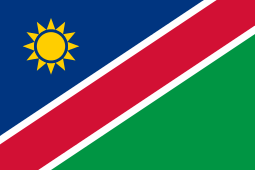 Namibia (White Namibians) – 6% of the population, of which most are Afrikaans-speaking, in addition to a German-speaking minority.[98]
Namibia (White Namibians) – 6% of the population, of which most are Afrikaans-speaking, in addition to a German-speaking minority.[98]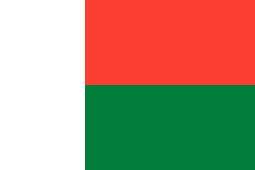 Madagascar (French people in Madagascar) – 113,000 people or 0.5% of the total population are white, mostly French. A further 76,000 are Réunionese Creole, bringing this total to 200,000 people and 1% of the total population.[99]
Madagascar (French people in Madagascar) – 113,000 people or 0.5% of the total population are white, mostly French. A further 76,000 are Réunionese Creole, bringing this total to 200,000 people and 1% of the total population.[99] Réunion (mostly of French descent) approx. 25% of the population.[100] Cafres usually have some degree of European descent.
Réunion (mostly of French descent) approx. 25% of the population.[100] Cafres usually have some degree of European descent. Zimbabwe – about 2% in the 2001 census. (Whites in Zimbabwe).
Zimbabwe – about 2% in the 2001 census. (Whites in Zimbabwe). Botswana – 5% European.[101]
Botswana – 5% European.[101] Kenya (Whites in Kenya).
Kenya (Whites in Kenya). Algeria (Pied-noir).
Algeria (Pied-noir). Mauritius (Franco-Mauritian).
Mauritius (Franco-Mauritian). Senegal – French/European and Lebanese communities.[102]
Senegal – French/European and Lebanese communities.[102]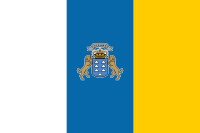 Canary Islands (Spaniards), known as Canarians.
Canary Islands (Spaniards), known as Canarians.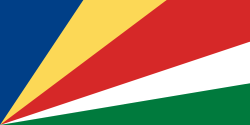 Seychelles (Franco-Seychellois).
Seychelles (Franco-Seychellois). Saint Helena, Ascension and Tristan da Cunha (UK) – predominantly British.
Saint Helena, Ascension and Tristan da Cunha (UK) – predominantly British. Swaziland – 3% of the population[103]
Swaziland – 3% of the population[103] Morocco – European expatriates, Spanish-descent Muslims (the Moorish era in Spain), Spanish Moroccan Roman Catholics from Spanish colonial time, and Franco-Moroccans from French colonial period.[104]
Morocco – European expatriates, Spanish-descent Muslims (the Moorish era in Spain), Spanish Moroccan Roman Catholics from Spanish colonial time, and Franco-Moroccans from French colonial period.[104] Tunisia – Small community of Europeans.[105]
Tunisia – Small community of Europeans.[105] Angola (Portuguese Angolans) – 1% are mostly Portuguese, with 2% are of mixed Portuguese and Angolan descent
Angola (Portuguese Angolans) – 1% are mostly Portuguese, with 2% are of mixed Portuguese and Angolan descent Mozambique (Portuguese Mozambicans) – 0.1% of the population is mostly Portuguese, with 0.2% of mixed Portuguese and native ancestry
Mozambique (Portuguese Mozambicans) – 0.1% of the population is mostly Portuguese, with 0.2% of mixed Portuguese and native ancestry
About 0-1 percent of the populations in Côte d'Ivoire, Ghana, Guinea, Liberia, Nigeria and Sierra Leone, usually are in the professional business elites. Not limited to Europeans, the "white" population includes Arab peoples: Lebanese and Syrians.[102]
Asia
- Asia
 Vietnam – approximately 441,000 people or 0.5% of the total population are Vietnamese Eurasians, mainly of French and American ancestry from former French and American soldiers and settlers.[106]
Vietnam – approximately 441,000 people or 0.5% of the total population are Vietnamese Eurasians, mainly of French and American ancestry from former French and American soldiers and settlers.[106] India (Anglo-Indian) – approximately 312,000 people or 0.02% of the total population are mixed White (mainly British) and Indian.[107]
India (Anglo-Indian) – approximately 312,000 people or 0.02% of the total population are mixed White (mainly British) and Indian.[107] Bangladesh (Anglo-Indian, Firingis or Portuguese) approximately 113,000 people or 0.1% of the total population are the descendents of former British settlers who intermarried with local populations. People of Chittagong are mixture of Bengali, Portuguese and Arab descent.[108]
Bangladesh (Anglo-Indian, Firingis or Portuguese) approximately 113,000 people or 0.1% of the total population are the descendents of former British settlers who intermarried with local populations. People of Chittagong are mixture of Bengali, Portuguese and Arab descent.[108] Myanmar (Anglo-Burmese, Anglo-Indian) – approximately 51,000 people or 0.1% of the total population are the descendents of former British settlers who intermarried with local populations.[109]
Myanmar (Anglo-Burmese, Anglo-Indian) – approximately 51,000 people or 0.1% of the total population are the descendents of former British settlers who intermarried with local populations.[109] Malaysia (Kristang people) – approximately 52,000 people or 0.2% of the total population are the descendents of former White settlers (including Portuguese, British, and Dutch) who intermaried with local populations.[110]
Malaysia (Kristang people) – approximately 52,000 people or 0.2% of the total population are the descendents of former White settlers (including Portuguese, British, and Dutch) who intermaried with local populations.[110] Sri Lanka (Burghers) – People of mixed Sri Lankan and European descent specifically of British, Dutch and Portuguese origins.
Sri Lanka (Burghers) – People of mixed Sri Lankan and European descent specifically of British, Dutch and Portuguese origins. Siberia (Russians)[111] – most are Russians and Russified Ukrainians, with approximately 400,000 Russified ethnic Germans, a number are part-European.
Siberia (Russians)[111] – most are Russians and Russified Ukrainians, with approximately 400,000 Russified ethnic Germans, a number are part-European. Kazakhstan (Russians in Kazakhstan, Tatars of Kazakhstan, Germans of Kazakhstan) – 31.5% of the population
Kazakhstan (Russians in Kazakhstan, Tatars of Kazakhstan, Germans of Kazakhstan) – 31.5% of the population Uzbekistan – 7% of the population[112] (See Demographics of Uzbekistan).
Uzbekistan – 7% of the population[112] (See Demographics of Uzbekistan). Kyrgyzstan – 13.5% of the population[113]
Kyrgyzstan – 13.5% of the population[113] Turkmenistan – 4% of the population[114]
Turkmenistan – 4% of the population[114]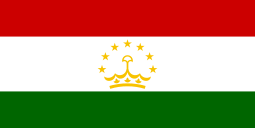 Tajikistan – Has a small European minority.
Tajikistan – Has a small European minority. Mongolia – 0.5% of the population or approximately 12,000 people are European, mostly of Ukrainian or Russian descent.[115]
Mongolia – 0.5% of the population or approximately 12,000 people are European, mostly of Ukrainian or Russian descent.[115] China (Russians in China)
China (Russians in China) Hong Kong - 0.8% of the population is white. (Britons in Hong Kong, Canadians in Hong Kong, Americans in Hong Kong, Russians in Hong Kong)[116]
Hong Kong - 0.8% of the population is white. (Britons in Hong Kong, Canadians in Hong Kong, Americans in Hong Kong, Russians in Hong Kong)[116] Macau (Macanese people) People of mainly mixed Chinese, however also South and Southeast Asian origins with some Portuguese ancestry.[117] There is also a significant community of Portuguese people in Macau who along with the Macanese people make up 2.0% of the total population.
Macau (Macanese people) People of mainly mixed Chinese, however also South and Southeast Asian origins with some Portuguese ancestry.[117] There is also a significant community of Portuguese people in Macau who along with the Macanese people make up 2.0% of the total population.  Singapore (Eurasians in Singapore) – Large numbers of Eurasians of mixed Asian and European descent reside in Singapore. Eurasian-Singaporeans are mostly of British, Portuguese, and Dutch descent.
Singapore (Eurasians in Singapore) – Large numbers of Eurasians of mixed Asian and European descent reside in Singapore. Eurasian-Singaporeans are mostly of British, Portuguese, and Dutch descent. Philippines (Filipino mestizo, Spanish settlement in the Philippines, American settlement in the Philippines) – An unknown number of Filipino-Eurasians either of Spanish or White American ancestry.
Philippines (Filipino mestizo, Spanish settlement in the Philippines, American settlement in the Philippines) – An unknown number of Filipino-Eurasians either of Spanish or White American ancestry. Indonesia (Indo people) – 14,000 people, mostly of mixed Indonesian and Dutch descent.[118]
Indonesia (Indo people) – 14,000 people, mostly of mixed Indonesian and Dutch descent.[118] Cambodia – approximately 16,000 people or 0.1% of the total population are Cambodian Eurasians, mainly of French ancestry from former French settlers.[119]
Cambodia – approximately 16,000 people or 0.1% of the total population are Cambodian Eurasians, mainly of French ancestry from former French settlers.[119] Pakistan (Europeans in Pakistan, Anglo-Indians or Anglo-Pakistanis) – approximately 11,000 people or 0.005% of the total population are the descendents of former British settlers who intermarried with local populations.[120]
Pakistan (Europeans in Pakistan, Anglo-Indians or Anglo-Pakistanis) – approximately 11,000 people or 0.005% of the total population are the descendents of former British settlers who intermarried with local populations.[120] Thailand – (Luk khrueng) An unknown number of people of mixed Thai and white origin.
Thailand – (Luk khrueng) An unknown number of people of mixed Thai and white origin.  East Timor – approximately 1,100 people or 0.08% of the total population are Portuguese, descended from former Portuguese settlers.[121]
East Timor – approximately 1,100 people or 0.08% of the total population are Portuguese, descended from former Portuguese settlers.[121]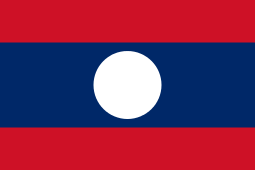 Laos – an unknown number of Eurasians with French ancestry who are the descendants of former French settlers reside in Laos.
Laos – an unknown number of Eurasians with French ancestry who are the descendants of former French settlers reside in Laos. Armenia – Armenia has a small minority of 21,000 Europeans, mostly of Russian and Ukrainian origin.[122]
Armenia – Armenia has a small minority of 21,000 Europeans, mostly of Russian and Ukrainian origin.[122] Azerbaijan (Russians in Azerbaijan)[123]
Azerbaijan (Russians in Azerbaijan)[123] Georgia (Russians in Georgia)[124]
Georgia (Russians in Georgia)[124]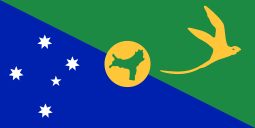 Christmas Island – approximately 13% of the total population are white, with a further 2% Eurasian, both are British Australian.[125]
Christmas Island – approximately 13% of the total population are white, with a further 2% Eurasian, both are British Australian.[125]_Islands.svg.png) Cocos (Keeling) Islands – 28.5% or one third of the total population are White, mostly British Australian.[126]
Cocos (Keeling) Islands – 28.5% or one third of the total population are White, mostly British Australian.[126]
Small communities of European, white American and white Australian expatriates live in East and Southeast Asia, such as China, Japan, South Korea, Thailand and Singapore.
- The Middle East
 Israel (Levantines, Circassians, ethnic Greeks, ethnic Russians, ethnic Armenians, ethnic Romanians)
Israel (Levantines, Circassians, ethnic Greeks, ethnic Russians, ethnic Armenians, ethnic Romanians) Lebanon (French Lebanese, Italian Lebanese, Greeks in Lebanon) – Small community of Europeans. (mainly from French, Italian, Greek and Americans from European origin)[127]
Lebanon (French Lebanese, Italian Lebanese, Greeks in Lebanon) – Small community of Europeans. (mainly from French, Italian, Greek and Americans from European origin)[127]
Small communities of European, white American and white Australian expatriates in the Persian Gulf countries like Bahrain, Kuwait, Qatar and the UAE; and in Aramco compounds in Saudi Arabia. Historically before 1970, small ethnic European (esp. Greek and Italian) enclaves were found in Egypt (Greeks in Egypt, Italian Egyptians) and Syria (Greeks in Syria).
Americas
| Part of a series on |
| European colonization of the Americas |
|---|
.svg.png) |
|
|
Total European population in the Americas—approximately 446,394,000
Europeans in Northern America
- Northern America –-- Total European population approximately 249,300,000
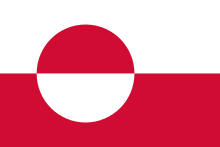 Greenland – 12% of the population or about 7,000 people, however the Greenlandic people are of any Scandinavian (majority being Danes) or Inuit-Eskimo descent.[128]
Greenland – 12% of the population or about 7,000 people, however the Greenlandic people are of any Scandinavian (majority being Danes) or Inuit-Eskimo descent.[128] Canada (Euro-Canadian) – 80% of the population, or 28,000,000 people, mostly divided into Anglophone (18 million) and Francophone (10 million).[129]
Canada (Euro-Canadian) – 80% of the population, or 28,000,000 people, mostly divided into Anglophone (18 million) and Francophone (10 million).[129] United States of America (European American) – 74% of the population, or 223,800,000 including Non-Hispanic Whites and White Hispanics.
United States of America (European American) – 74% of the population, or 223,800,000 including Non-Hispanic Whites and White Hispanics.
Europeans in Latin America and the Caribbean
- Middle America (including Central America and the Caribbean) and South America (see White Latin American) -- Total European population approximately 197,094,000
 Argentina – 79% of the population or 38,900,000, may include an unknown percentage of mestizos and mulattos.[130] Other sources[131] put 86.4% of the population as white, with a higher number of mestizos.
Argentina – 79% of the population or 38,900,000, may include an unknown percentage of mestizos and mulattos.[130] Other sources[131] put 86.4% of the population as white, with a higher number of mestizos. Bahamas (European Bahamian) – 12% of the population or 39,600, the majority are African or other races.[132]
Bahamas (European Bahamian) – 12% of the population or 39,600, the majority are African or other races.[132]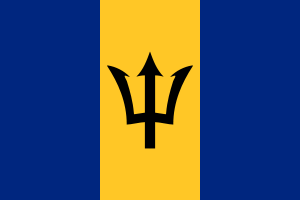 Barbados (White Barbadian) – 4% of the population or 11,238, it's thought to be the highest of all British West Indies islands.[133]
Barbados (White Barbadian) – 4% of the population or 11,238, it's thought to be the highest of all British West Indies islands.[133] Bermuda – 34.1% of the population or 23,064, with a black or part-white/black majority.[134]
Bermuda – 34.1% of the population or 23,064, with a black or part-white/black majority.[134] Bolivia – 15% of the population or 1,636,000, the country except for Paraguay and Ecuador have the lowest white populations of South America.[135]
Bolivia – 15% of the population or 1,636,000, the country except for Paraguay and Ecuador have the lowest white populations of South America.[135] Brazil (White Brazilian) – 49.7% of the population or 93,000,000. Another 42.6% are pardos of mixed White, African and/or Amerindian descent (showed by genetic research to be of predominant European ancestry). Afro-Brazilians by genetical research showed to be of about 37.1% European ancestry (the majority inherited by colonial or Imperial times and of Portuguese origin). Some people of claimed Asian and Indigenous origin can also have European descent.[136]
Brazil (White Brazilian) – 49.7% of the population or 93,000,000. Another 42.6% are pardos of mixed White, African and/or Amerindian descent (showed by genetic research to be of predominant European ancestry). Afro-Brazilians by genetical research showed to be of about 37.1% European ancestry (the majority inherited by colonial or Imperial times and of Portuguese origin). Some people of claimed Asian and Indigenous origin can also have European descent.[136] Chile – 52.7% (9,100,000) is white in Chile.[137]
Chile – 52.7% (9,100,000) is white in Chile.[137] Colombia – 86% of the population are (white Colombian) or part white (mestizo or mulatto).[6][7]
Colombia – 86% of the population are (white Colombian) or part white (mestizo or mulatto).[6][7]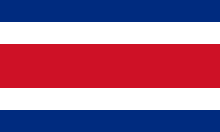 Costa Rica – up to 90% white and/or mestizo (European and Amerindian descent); 80-85% is white and 10-15% mestizo, or 3,827,000 (3,400,000 and 427,000).[138]
Costa Rica – up to 90% white and/or mestizo (European and Amerindian descent); 80-85% is white and 10-15% mestizo, or 3,827,000 (3,400,000 and 427,000).[138] Cuba – 64.1% of the population or 7,160,399[13]
Cuba – 64.1% of the population or 7,160,399[13] Dominican Republic – 16% of the population or 1,655,959 is white and an additional 73% are mulatto or 7,555,311. In total, 89% of the Dominican population is either fully or partially of European ancestry.[139]
Dominican Republic – 16% of the population or 1,655,959 is white and an additional 73% are mulatto or 7,555,311. In total, 89% of the Dominican population is either fully or partially of European ancestry.[139] Ecuador – 6% of the population or 940,000, while 72% are mestizos.[140]
Ecuador – 6% of the population or 940,000, while 72% are mestizos.[140] El Salvador – 9% of the population or 720,000, but the remainder 90% have some European ancestry.[141]
El Salvador – 9% of the population or 720,000, but the remainder 90% have some European ancestry.[141] French Guiana – 12% of the population or 26,000, but the French government insists all citizens of France regardless of race are "French".[142]
French Guiana – 12% of the population or 26,000, but the French government insists all citizens of France regardless of race are "French".[142] Guatemala 18% of the population or 2,490,000 people.
Guatemala 18% of the population or 2,490,000 people.  Haiti – 4% of the population in Haiti are white and mulatto (both African and European ancestry) and 1% European, or 97,000. White Haitians are chiefly of French, Italian, or German origin not including Middle Eastern & North American whites. This figure excludes the percentage of Haitians with less than noticeable European admixture.
Haiti – 4% of the population in Haiti are white and mulatto (both African and European ancestry) and 1% European, or 97,000. White Haitians are chiefly of French, Italian, or German origin not including Middle Eastern & North American whites. This figure excludes the percentage of Haitians with less than noticeable European admixture. Jamaica – Approximately 2% of the population or 40,000 people are White, mainly British, American, and Portuguese (This number increases to 60,000 people and 3% of the total population when Arabs and Lebanese are included). However, the vast majority of the population in Jamaica have some degree of European Ancestry.[143]
Jamaica – Approximately 2% of the population or 40,000 people are White, mainly British, American, and Portuguese (This number increases to 60,000 people and 3% of the total population when Arabs and Lebanese are included). However, the vast majority of the population in Jamaica have some degree of European Ancestry.[143] Martinique – 2% of the population or 8,000, with another 3% mulatto descent.[144]
Martinique – 2% of the population or 8,000, with another 3% mulatto descent.[144] Mexico[145] (White Mexican) – About 16.5% of the population European or about 20,160,000, and an additional 70% of mixed European and Amerindian descent[146][147][148]
Mexico[145] (White Mexican) – About 16.5% of the population European or about 20,160,000, and an additional 70% of mixed European and Amerindian descent[146][147][148] Nicaragua – 17% of the population or 1,000,000 people, and 69% mestizo.[149]
Nicaragua – 17% of the population or 1,000,000 people, and 69% mestizo.[149] Panama 14.0% of the population is White of European origin or 352,000 people, 58.1% mestizo, 7% mulatto, 6.7% Amerindian, 5.5% Asian, and 7.1% other (2000 Census).
Panama 14.0% of the population is White of European origin or 352,000 people, 58.1% mestizo, 7% mulatto, 6.7% Amerindian, 5.5% Asian, and 7.1% other (2000 Census).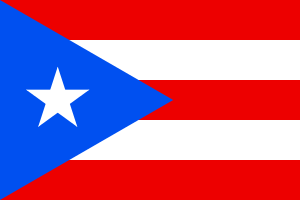 Puerto Rico 75.8% of the population or 3,620,897 self identify as having European ancestry. 12.4% is of black or African-American ancestry and 8.5% are of other ancestry, including American Indian. 3.3% identify as mixed.[150]
Puerto Rico 75.8% of the population or 3,620,897 self identify as having European ancestry. 12.4% is of black or African-American ancestry and 8.5% are of other ancestry, including American Indian. 3.3% identify as mixed.[150] Peru (European Peruvian) – 15% of the population or 3,425,000, about 40% mestizo or partial European descent.[151]
Peru (European Peruvian) – 15% of the population or 3,425,000, about 40% mestizo or partial European descent.[151]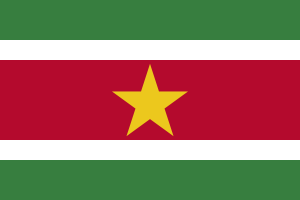 Suriname – Surinamese Creoles, mixed people descending from West African slaves and mostly Dutch Europeans, form 15.7 percent of the population.
Suriname – Surinamese Creoles, mixed people descending from West African slaves and mostly Dutch Europeans, form 15.7 percent of the population.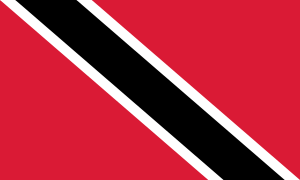 Trinidad and Tobago – 1.7% of European descent or 24,600, mainly British, Spanish, French, German, and Portuguese, with a number of Scandinavian descent, although 30-40% have East Indian or 5% are Lebanese/Syrian Arab backgrounds.[152]
Trinidad and Tobago – 1.7% of European descent or 24,600, mainly British, Spanish, French, German, and Portuguese, with a number of Scandinavian descent, although 30-40% have East Indian or 5% are Lebanese/Syrian Arab backgrounds.[152] Venezuela (white Venezuelan) – 42,2% of the population or 11,490,018, about 49,9% are part white (mestizo or partial European descent.) making it 92,1% of the population white and/or mestizo (European and Amerindian descent) or 25,076,755.[153]
Venezuela (white Venezuelan) – 42,2% of the population or 11,490,018, about 49,9% are part white (mestizo or partial European descent.) making it 92,1% of the population white and/or mestizo (European and Amerindian descent) or 25,076,755.[153] Uruguay – 88% of the population or 3,074,000, the rest have various levels of European descent.[154]
Uruguay – 88% of the population or 3,074,000, the rest have various levels of European descent.[154] Saint Barthélemy—90% or 7,940; Saint Martin (Statistics not available).[155]
Saint Barthélemy—90% or 7,940; Saint Martin (Statistics not available).[155]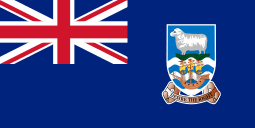 Falkland Islands, 100% European of British descent—total population 3,140.
Falkland Islands, 100% European of British descent—total population 3,140.
The Virgin Islands divided between U.S. Virgin Islands and the British Virgin Islands, each have a small European minority.
Oceania
- Oceania -- Total population of Europeans in Oceania is approximately 23,185,000 or approximately 22,818,000 excluding Hawaii.
 Australia (European Australian) – 93.2% of the population or 20,299,000 people. People of aboriginal extraction number about 548,400, of which approximately 60,000 can speak Australian languages or Kriol.[156]
Australia (European Australian) – 93.2% of the population or 20,299,000 people. People of aboriginal extraction number about 548,400, of which approximately 60,000 can speak Australian languages or Kriol.[156] New Zealand (New Zealand European) – 59.1% of the population or 2,361,000, plus some Māori of mixed white-European descent.
New Zealand (New Zealand European) – 59.1% of the population or 2,361,000, plus some Māori of mixed white-European descent.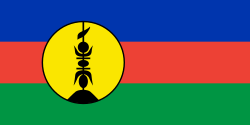 New Caledonia (Caldoche) – 44.6% of the population or about 112,050; the territory is under French rule.
New Caledonia (Caldoche) – 44.6% of the population or about 112,050; the territory is under French rule.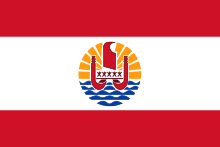 French Polynesia – 10% of the population (mostly French with some white Americans) or 26,700, and 6 to 8% are Euronesian (part white-Polynesian).[157]
French Polynesia – 10% of the population (mostly French with some white Americans) or 26,700, and 6 to 8% are Euronesian (part white-Polynesian).[157]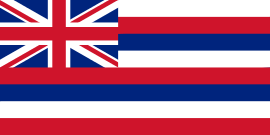 Hawaii – Europeans are 27.1% of the population (2008 survey) or 367,000 (called Haoles), although 65% of all Hawaiians have white-European descent.
Hawaii – Europeans are 27.1% of the population (2008 survey) or 367,000 (called Haoles), although 65% of all Hawaiians have white-European descent.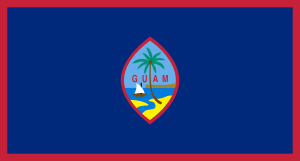 Guam – 10% of the population have Spanish and white American descent (2000 Census) or about 17,800 people. Guam has a history of Spanish settlement before 1900, now a U.S. territory.[158]
Guam – 10% of the population have Spanish and white American descent (2000 Census) or about 17,800 people. Guam has a history of Spanish settlement before 1900, now a U.S. territory.[158] Norfolk Island, about 50% British-Polynesian from Pitcairn Island (1,070 people) and 50% white-British descent mainly via Australia (1,070 people).
Norfolk Island, about 50% British-Polynesian from Pitcairn Island (1,070 people) and 50% white-British descent mainly via Australia (1,070 people).
Contemporary European diasporas
- Albanian diaspora
- Armenian diaspora
- Basque diaspora
- Bosnian diaspora
- British diaspora
- Bulgarian diaspora
- Circassian diaspora
- Croatian diaspora
- Czech diaspora
- Dutch diaspora
- English diaspora
- French diaspora
- German diaspora
- Greek diaspora
- Hungarian diaspora
- Icelandic diaspora
- Irish diaspora
- Italian diaspora
- Kosovan diaspora
- Lithuanian diaspora
- Macedonian diaspora
- Maltese diaspora
- Norwegian diaspora
- Polish diaspora
- Portuguese diaspora
- Romanian diaspora
- Russian diaspora
- Scottish diaspora
- Serbian diaspora
- Spanish diaspora
- Swedish diaspora
- Swiss diaspora
- Ukrainian diaspora
- Ruthenians or Rusyns
- Welsh diaspora
Potential emigrants
According to a 2010 Gallup study, an estimated 80 million adults in the European Union would prefer to emigrate if given free choice. About half of these would migrate to another country within the EU. The remaining 40 million have a desired destination outside of the EU, about 14 million would migrate to North America (USA or Canada), and 9 million to Australia or New Zealand.[159]
See also
- Emigration from Africa
- History of colonialism
- Immigration to Europe
- Indigenous people
- Western world
- Western culture
- White people
References
- ↑ Current World Population 2016 worldometers
- 1 2 "Overview of Race and Hispanic Origin: 2010 Census Briefs". US Census Bureau. March 2011. Archived from the original (PDF) on 5 May 2011.
- ↑ "Tabelas de resultados Branca Preta Amarela Parda Indígena Sem declaração" (PDF). 8 November 2011. Retrieved 2014-07-11.
- ↑ "South America : Argentina : People and society". The World Factbook. CIA. Retrieved 23 July 2015.
- 1 2 "National Household Survey (NHS) Profile, 2011". Retrieved 17 June 2015.
- 1 2 Bushnell, David & Rex A. Hudson (2010) "The Society and Its Environment"; Colombia: a country study: 87. Washingtion D.C.: Federal Research Division, Library of Congress.
- 1 2 "White Colombians" (PDF). Retrieved 2014-01-16.
- ↑ Resultado Basico del XIV Censo Nacional de Población y Vivienda 2011 Venezuela 2011 Census, (p. 14).
- ↑ http://www.ine.gob.ve/ INE : (adapted the % of 41,1% white people from the census with the actual new official census results
- 1 2 3 4 5 "Ethnic groups". The World Factbook. Central Intelligence Agency (CIA). Retrieved 2013-09-14.
- 1 2 3 4 5 6 7 8 Francisco Lizcano Fernández (2005). "Composición Étnica de las Tres Áreas Culturales del Continente Americano al Comienzo del Siglo XXI" (PDF). UAEM. p. 218. Archived from the original (PDF) on 20 September 2008.
- 1 2 "Mexico: People; Ethnic groups". CIA World Factbook. Retrieved 2007-11-26.
- 1 2 3 "2012 Cuban Census" (PDF). one.cu (in Spanish). 2013. Archived from the original (PDF) on 3 June 2014.
- ↑ "South Africa: Statistical release P0302: Mid-year population estimates 2009: Embargoed until: 27 July 2009" (PDF). Statistics South Africa. 2009. Retrieved 19 December 2015.
- ↑ "Chile". Encyclopædia Britannica. Retrieved 2012-09-15.
"Chile's ethnic makeup is largely a product of Spanish colonization. About three-fourths of Chileans are mestizo, a mixture of European and Amerindian ancestries. One fifth of Chileans are of white European (mainly Spanish) descent".
- ↑ Ernesto Medina-Lois&Ana María Kaempffer Elementos de Salud Pública, Universidad de Chile. (See: Chapter 5.2.6 Estructura racial)
- ↑ Statistics New Zealand Highlights: Ethnic groups in New Zealand
- 1 2 "Atlas Sociodemografico y de la Desigualdad en Uruguay , 2011: Ancestry" (PDF) (in Spanish). National Institute of Statistics. Archived from the original (PDF) on 2014-02-09.
- ↑ 2010 Census Data. "2010 Census Data". 2010.census.gov. Archived from the original on 2011-01-02. Retrieved 2011-10-30.
- 1 2 INE- Caracterización estadística República de Guatemala 2012 Retrieved, 2015/04/17.
- ↑ The Socioeconomic Advantages of Mestizos in Urban Peru. princeton.edu. pp. 4-5.
- ↑ Nacional de Estadística y Censo del Ecuador INEC.
- 1 2 "European Migration and Imperialism". Archived from the original on 2010-11-22. Retrieved 2013-09-14.
The population of Europe entered its third and decisive stage in the early eighteenth century. Birthrates declined, but death rates also declined as the standard of living and advances in medical science provided for longer life spans. The population of Europe including Russia more than doubled from 188 million in 1800 to 432 million in 1900. From 1815 through 1932, sixty million people left Europe, primarily to "areas of European settlement," in North and South America, Australia, New Zealand and Siberia. These populations also multiplied rapidly in their new habitat; much more so than the populations of Africa and Asia. As a result, on the eve of World War One (1914), 38 percent of the world’s total population was of European ancestry. This growth in population provided further impetus for European expansion, and became the driving force behind emigration. Rising populations put pressure on land, and land hunger and led to "land hunger." Millions of people went abroad in search of work or economic opportunity. The Irish, who left for America during the great Potato famine, were an extreme but not unique example. Ultimately, one third of all European migrants came from the British Isles between 1840 and 1920. Italians also migrated in large numbers because of poor economic conditions in their home country. German migration also was steady until industrial conditions in Germany improved when the wave of migration slowed. Less than one half of all migrants went to the United States, although it absorbed the largest number of European migrants. Others went to Asiatic Russia, Canada, Argentina, Brazil, Australia and New Zealand.
- 1 2 Baily, Samuel L.; Míguez, Eduardo José, eds. (2003). Mass Migration to Modern Latin America. Wilmington, Delaware, United States of America. p. 14. ISBN 0-8420-2831-5. Retrieved 3 March 2016.
- 1 2 Blanca Sánchez-Alonso (2005). "European Immigration into Latin America, 1870-1930" (PDF). docentes.fe.unl.pt. Archived from the original (PDF) on 22 October 2008.
- ↑ Western North Africa, 1–500 A.D., The Metropolitan Museum of Art
- ↑ Archaeologists Find Celts In Unlikely Spot: Turkey, New York Times
- ↑ "Diversity in the Desert: Daily Life in Greek and Roman Egypt (332 B.C.E. – 641 C.E.): People". lib.umich.edu. 2007. Archived from the original on 11 March 2008.
- ↑ Alexander the Great and precious stones in Afghanistan, The Toronto Times
- ↑ "Cyril and Methodius of Thessalonica: The Acculturation of the Slavs". Retrieved 17 June 2015.
- ↑ "The Fate of Greenland's Vikings – Archaeology Magazine Archive". Retrieved 17 June 2015.
- ↑ Benjamin Z. Kedar, "The Subjected Muslims of the Frankish Levant", in The Crusades: The Essential Readings, ed. Thomas F. Madden, Blackwell, 2002, pg. 244. Originally published in Muslims Under Latin Rule, 1100–1300, ed. James M. Powell, Princeton University Press, 1990. Kedar quotes his numbers from Joshua Prawer, Histoire du royaume latin de Jérusalem, tr. G. Nahon, Paris, 1969, vol. 1, pp. 498, 568-72.
- ↑ Crusaders 'left genetic legacy', BBC News
- 1 2 Boris Fautos – Fazer a América: a imigração em massa para a América Latina."
- ↑ Marília D. Klaumann Cánovas (2004). "A GRANDE IMIGRAÇÃO EUROPÉIA PARA O BRASIL E O IMIGRANTE ESPANHOL NO CENÁRIO DA CAFEICULTURA PAULISTA: ASPECTOS DE UMA (IN)VISIBILIDADE" [The great European immigration to Brazil and immigrants within the Spanish scenario of the Paulista coffee plantations: one of the issues (in) visibility] (PDF) (in Portuguese). cchla.ufpb.br. Archived from the original (PDF) on 3 October 2009.
- 1 2 3 4 5 6 7 8 9 10 Samuel L. Baily; Eduardo José Míguez (2003). Mass Migration to Modern Latin America. Rowman & Littlefield. p. xiv. ISBN 978-0-8420-2831-8. Retrieved 20 December 2015.
- ↑ Raza de la Población Total, por Provincias, Incluyendo Porcentajes Censo de Población de Costa Rica 1927
- ↑ Multiculturalism and Immigration in Canada: An Introductory Reader By Elspeth Cameron (Page: 73-73)
- ↑ Ethnic origins Census of Canada (Page: 17)
- ↑ Summary Population, Housing Characteristics. Puerto Rico: 2000 Census. (Page 52).
- ↑ "Puerto Rico: People; Ethnic groups". 2010.census.gov. Archived from the original on 2011-05-31. Retrieved 2011-04-14.
- ↑ "Official census statistics of the United States race and Hispanic origin population" (PDF). Census.gov.
- ↑ A Population History of North America By Michael R. Haines, Richard H. Steckel
- ↑ Cifras censales comparadas, 1899 - 1953 (Page: 189)
- ↑ Population of the British Colonies in America Before 1776: A Survey of ... By Robert V. Wells. "In 1698, 61.7% of the population was white and 38.3% black".
- ↑ "Bermuda 2010 Census" (PDF). Bermuda Department of Statistics. December 2011. Retrieved 20 November 2012.
- ↑ "Nicaragua: People; Ethnic groups". CIA World Factbook. Retrieved 2007-11-26.
- ↑ Frank Moya Pons (1999). Breve Historia Contemporánea de la República Dominicana (in Spanish). Fondo De Cultura Economica USA. p. 62.
Según los datos del primer censo nacional, la población dominicana estaba compuesta por un 24.9% de blancos, (...) en 1920 había 223 144 blancos (...)
- ↑ "La variable étnico racial en los censos de población en la República Dominicana" (in Spanish). Oficina Nacional de Estadística. Archived from the original on 2013-07-29.
- ↑ "D.R.: People; Ethnic groups". CIA World Factbook. Retrieved 2007-11-26.
- ↑ Caribbean Ethnicity Revisited, Issues 2-3 (Page: 47) By Stephen D. Glazier
- ↑ Census of Population: 1960, Volume 1 By United States. Bureau of the Census
- ↑ 2010 Census U.S. Virgin Islands: Race
- ↑ Censo de la Republica de Panama 1940 Census
- ↑ "Panama: People; Ethnic groups". CIA World Factbook. Retrieved 2007-11-26.
- ↑ Resumen del Censo General de Habitantes de 1921 - INEGI Razas -(Page: 62)
- ↑ "El Salvador: Censos de Población 2007" [El Salvador: Population Census 2007] (PDF) (in Spanish). digestyc.gob.sv. 2008. p. 13. Retrieved 20 December 2015.
- ↑ Turks and Caicos 2001 Census (Page: 22)
- ↑ National Population Census Report 2001, The British Virgin Islands Percentage Distribution of Population by Ethnic Group, Intercensal Change and Sex, 1991 and 2001 White/Caucasian 6.80% + Portuguese 0.10%.
- ↑ Population of the British Colonies in America Before 1776: A Survey of ... By Robert V. Wells (Page: 183)
- ↑ Bahamas 2010 census TOTAL POPULATION BY SEX, AGE GROUP AND RACIAL GROUP "In 1722 when the first official census of The Bahamas was taken, 74% of the population was white and 26% black. Three centuries later, and according to the 99% response rate obtained from the race question on the 2010 Census questionnaire, 91% of the population identified themselves as being black, five percent (5%) white and two percent (2%) of a mixed race (black and white)." (Page: 10 and 82)
- ↑ Bahamas 2010 census TOTAL POPULATION BY SEX, AGE GROUP AND RACIAL GROUP "In 1722 when the first official census of The Bahamas was taken, 74% of the population was white and 26% black. Three centuries later, and according to the 99% response rate obtained from the race question on the 2010 Census questionnaire, 91% of the population identified themselves as being black, five percent (5%) white and two percent (2%) of a mixed race (black and white) and (1%) other races and (1%) not stated." (Page: 10 and 82)
- ↑ Anguilla Population and Housing Census (AP&HC) 2011 Who are we? – Ethnic Composition and Religious Affiliation.
- ↑ BARBADOS - 2010 POPULATION AND HOUSING CENSUS Table 02.03: Population by Sex, Age Group and Ethnic Origin (Page: 51-54)
- ↑ POPULATION, DEMOGRAPHIC CHARACTERISTICS POPULATION BY ETHNIC GROUPS (Page:16-17) 1.4% white (608 "Portuguese" and 870 other "white").
- ↑ "Encuesta Contínua de Hogares 1996-1997". Instituto Nacional de Estadística de Uruguay (Spanish)
- ↑ Ethnic Groups Worldwide: A Ready Reference Handbook. by David Levinson. Page 313. Greenwood Publishing Group, 1998. ISBN 1-57356-019-7
- ↑ "The World Factbook". cia.gov. Retrieved 2014-04-12.
- ↑ Race and ethnicity in Brazil
- ↑ "2010 Brazilian Census" (PDF). ibge.gov.br (in Portuguese). 2011. Retrieved 19 December 2015.
- ↑ Resultado Basico del XIV Censo Nacional de Población y Vivienda 2011, (p. 14).
- ↑ Colombia: país fragmentado, sociedad dividida : su historia By Marco Palacios, Frank Safford
- ↑ Library of Congress Country Studies. "Colombia: Race and Ethnicity". Retrieved on April 12, 2011.
- ↑ Colombia a country study, 2010 (pag 86,87) (English)
- ↑ Simon Schwartzman (25 July 2008). "Étnia, condiciones de vida y discriminación" (PDF). Retrieved 2014-07-11.
- ↑ ENFOQUE INTERCULTURAL-APORTES PARA LA GESTIÓN PÚBLICA La Encuesta Nacional de Hogares (ENAHO 2012) Page:17.
- ↑ 'Central Intelligence Agency of the United States- (statistics) '
- ↑ Etnicidad y exclusion en Ecuador: censo de población de 2001
- ↑ EL UNIVERSO. "Población del país es joven y mestiza, dice censo del INEC". El Universo. Retrieved 17 June 2015.
- ↑ Censo National De La Poblacion de la Republica - 1900 Census of Bolivia. "Segunda parte" - (Page: 25 - 32)
- ↑ "Bolivia: People; Ethnic groups". CIA World Factbook. Retrieved 2007-11-26.
- ↑ "Australia today: Table 1.1 Ethnic Composition of the Australian People (per cent)". Department of Social Security, Settlement and Multicultural Affairs. 7 November 2014. Retrieved 24 December 2015.
- ↑ David Dutton (2002). One of Us?: A Century of Australian Citizenship. UNSW Press. p. 39. ISBN 978-0-86840-556-8. Retrieved 3 February 2016.
- ↑ "4. AUSTRALIA.-MALES, FEMALES and PERSONS classified according to RACE: Censuses, 1921 to 1947." (PDF). Census of the Commonwealth of Australia 1947, Part XV - Race. 30 June 1947. p. 829. Retrieved 3 February 2016.
- ↑ 2006 Census Tables : Australia
- ↑ "Australia: Ethnic Groups". Britannica Online for Kids. 2014. Retrieved 17 December 2015.
- ↑ Historical and stastical survey (Page:18)
- ↑ "2013 Census QuickStats about national highlights". Archived from the original on 2014-07-14. Retrieved 17 June 2015.
- ↑ France in the South Pacific: Power and Politics By Denise Fisher (Page: 107)
- ↑ Estimer appartenir à une ou plusieurs communautés 2009 census - New Caledonia according to ethnic group
- ↑ Guam (Territory of the US) CIA Factbook - based on the 2010 official Census statistics
- ↑ The Northern Mariana Islands 2010 Census
- ↑ Census of South Africa
- ↑ Census 2011: Census in brief (PDF). Pretoria: Statistics South Africa. 2012. ISBN 9780621413885.
- ↑ Namibia-Travel - retrieved 3rd February 2016
- ↑ Ethnic groups by country. Statistics (where available) from CIA Factbook.
- ↑ South Africa: People: Ethnic Groups. World Factbook of CIA
- ↑ Namibia: People: Ethnic Groups. World Factbook of CIA
- ↑ "Country – Madagascar :: Joshua Project". joshuaproject.net. Retrieved 2014-07-11.
- ↑ "Anthropometric evaluations of body composition of undergraduate students at the University of La Réunion". Retrieved 17 June 2015.
- ↑ Botswana: People: Ethnic Groups. World Factbook of CIA
- 1 2 Senegal, About 50,000 Europeans (mostly French) and Lebanese reside in Senegal, mainly in the cities.
- ↑ Swaziland: People: Ethnic Groups. World Factbook of CIA
- ↑ Morocco: People: Ethnic Groups. World Factbook of CIA
- ↑ Tunisia: People: Ethnic Groups. World Factbook of CIA
- ↑ "Country – Vietnam :: Joshua Project". joshuaproject.net. Retrieved 2014-07-11.
- ↑ "Country – India :: Joshua Project". joshuaproject.net. Retrieved 2014-07-11.
- ↑ "Country – Bangladesh :: Joshua Project". joshuaproject.net. Retrieved 2014-07-11.
- ↑ "Country – Myanmar (Burma) :: Joshua Project". joshuaproject.net. Retrieved 2014-07-11.
- ↑ "Country – Malaysia :: Joshua Project". joshuaproject.net. Retrieved 2014-07-11.
- ↑ Fiona Hill, Russia — Coming In From the Cold?, The Globalist, 23 February 2004
- ↑ Robert Greenall, Russians left behind in Central Asia, BBC News, 23 November 2005.
- ↑ Kyrgyzstan: People: Ethnic Groups. World Factbook of CIA
- ↑ Turkmenistan: People: Ethnic Groups. World Factbook of CIA
- ↑ "Country – Mongolia :: Joshua Project". joshuaproject.net. Retrieved 2014-07-11.
- ↑ HK Census. "HK Census." Statistical Table. Retrieved on 2007-03-08.
- ↑ João de Pina-Cabral (2002). Between China and Europe: person, culture and emotion in Macao. Volume 74 of London School of Economics monographs on social anthropology (illustrated ed.). Berg. p. 39. ISBN 0-8264-5749-5. Retrieved 2012-03-01.
To be a Macanese is fundamentally to be from Macao with Portuguese ancestors, but not necessarily to be of Sino-Portuguese descent. The local community was born from Portuguese men. ... but in the beginning the woman was Goanese, Siamese, Indo-Chinese, Malay - they came to Macao in our boats. Sporadically it was a Chinese woman.
- ↑ "Country – Indonesia :: Joshua Project". joshuaproject.net. Retrieved 2014-07-11.
- ↑ "Country – Cambodia :: Joshua Project". joshuaproject.net. Retrieved 2014-07-11.
- ↑ "Country – Pakistan :: Joshua Project". joshuaproject.net. Retrieved 2014-07-11.
- ↑ "Country – East Timor :: Joshua Project". joshuaproject.net. Retrieved 2014-07-11.
- ↑ "Country – Armenia :: Joshua Project". joshuaproject.net. Retrieved 2014-07-11.
- ↑ "Southern Caucasus: Facing Integration Problems, Ethnic Russians Long For Better Life". EurasiaNet.org. Retrieved 17 June 2015.
- ↑ Georgia: Ethnic Russians Feel Insulated From Tensions, Radio Free Europe
- ↑ "Country – Christmas Island :: Joshua Project". joshuaproject.net. Retrieved 2014-07-11.
- ↑ "Country – Cocos (Keeling) Islands :: Joshua Project". joshuaproject.net. Retrieved 2014-07-11.
- ↑ "The World Factbook". cia.gov. Retrieved 2014-07-11.
- ↑ "greenland". Retrieved 17 June 2015.
- ↑ "Canadian Census 2006". Archived from the original on 4 December 2008. Retrieved 17 June 2015.
- ↑ Argentina: People: Ethnic Groups. World Factbook of CIA
- ↑ Ben Cahoon. "Argentina". worldstatesmen.org. Retrieved 23 July 2015.
- ↑ Bahamas: People: Ethnic Groups. World Factbook of CIA
- ↑ Barbados: People: Ethnic Groups. World Factbook of CIA
- ↑ Bermuda: People: Ethnic Groups. World Factbook of CIA
- ↑ Bolivia: People: Ethnic Groups. World Factbook of CIA
- ↑ "Estudos e Pesquisas Informação Demográfi ca e Socioeconômica número 19: Síntese de Indicadores Sociais 2006. Tabela 9.1" [Studies & Research: Demographic and Socio-Economic Information: Summary of Social Indicators 2006: Table 9.1] (PDF) (in Portuguese). Instituto Brasileiro de Geografi a e Estatística - IBGE. 2006. p. 248. Archived from the original (PDF) on 4 March 2007. Retrieved 18 August 2009.
- ↑ Francisco Lizcano Fernández (2007). Iberoamérica. Un área cultural heterogénea. Universidad Autónoma del Estado de México. p. 93. ISBN 978-970-757-052-8.
- ↑ "Costa Rica; People; Ethnic groups". CIA World Factbook. Retrieved 2007-11-21.
white (including mestizo) 94%
= 3.9 million whites and mestizos. - ↑ Dominican Republic: People: Ethnic groups. World Factbook of CIA
- ↑ "Ecuador: People; Ethnic groups". CIA World Factbook. Retrieved 2014-03-19.
- ↑ El Salvador: People: Ethnic Groups. World Factbook of CIA
- ↑ French Guiana: People: Ethnic Groups. World Factbook of CIA
- ↑ "Country – Jamaica :: Joshua Project". joshuaproject.net. Retrieved 2014-07-11.
- ↑ Martinique: People: Ethnic Groups. World Factbook of CIA
- ↑ North America – Britannica Concise Encyclopedia Archived 12 May 2008 at the Wayback Machine.
- ↑ "Mexico". Encyclopedia Britannica. Retrieved 17 June 2015.
- ↑ Mexico: People: Ethnic Groups. World Factbook of CIA
- ↑ "Mexico -- Encyclopedia Britannica". britannica.com. Retrieved 2014-07-11.
- ↑ "Nicaragua: People; Ethnic groups". CIA World Factbook. Retrieved 2007-11-15.
- ↑ "Puerto Rico: People: Ethnic Groups" (2014). CIA World Factbook, www.cia.gov. Retrieved May 23, 2014
- ↑ Peru: People: Ethnic Groups. World Factbook of CIA
- ↑ Gertrud Aub-Buscher. "Language Varieties: Trinidad French Creole". hawaii.edu. Retrieved 18 December 2015.
- ↑ Luis Ibarr (24 August 2012). "RESULTADOS BÁSICOS Censo 2011, Caracas, 09/08/2012" (PDF). Retrieved 2014-07-11.
- ↑ Uruguay: People: Ethnic Groups. World Factbook of CIA
- ↑ "Fact Sheet on St. Barthélemy -- 1995". Retrieved 17 June 2015.
- ↑ "Census of Population and Housing: Characteristics of Aboriginal and Torres Strait Islander Australians, 2011". Australian Bureau of Statistics. 27 November 2012. Retrieved 21 December 2014.
- ↑ French Polynesia: People: Ethnic Groups. World Factbook of CIA
- ↑ Brazil: People: Ethnic Groups. World Factbook of CIA
- ↑ Neli Esipova, Julie Ray, and Rajesh Srinivasan, The World’s Potential Migrants, Gallup, 2010., p. 8.